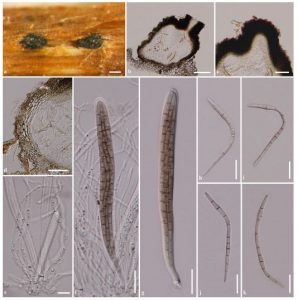Ophiobolopsis italica Phookamsak, Wanas., E. Camporesi & K.D. Hyde, sp. nov. Index Fungorum number: IF553919
Etymology: The epithet ‘‘italica’’ refers to the country Italy, where the fungus was collected.
Saprobic on Ononis spinosa L. Sexual morph: Ascomata 270–370 μm high (including papilla), 370–470 μm diam., dark brown to black, scattered, solitary, semi-immersed to erumpent through the host epidermis, subglobose to ampulliform, or irregular in shape, uni-loculate, glabrous, ostiolate, papillate. Papilla 100–140 μm high, 70–160 μm diam., mammiform, with rounded to truncate apex, composed of several layers of dark brown to black cells, arranged in a textura angularis to textura prismatica, ostiole central, with indistinct periphyses. Peridium 25–55 μm wide, thin at the base, thicker towards the apex, composed of several cell layers of small to large, brown to dark brown pseudoparenchymatous cells, arranged in textura angularis to textura prismatica. Hamathecium composed of dense, 2–5 μm wide, broadly cellular pseudoparaphyses, narrower towards the apex, anastomising, distinctly septate, deeply constricted at the septa near the base, embedded in a hyaline gelatinous matrix. Asci (145–)150–165(–170) x 12–14(–15) μm (x = 155.8 x 13.4 μm, n = 30), 4-spored, bitunicate, fifissitunicate, cylindrical to cylindric-clavate, short pedicellate, apically rounded, with well-developed ocular chamber. Ascospores 100–120 x 4–5 μm (x = 111 9 4.8 μm, n = 30), fasciculate, scolecosporous, pale brown to yellowish brown, elongate cylindrical, with rounded ends, slightly tapered towards the lower cell, curved, 9(–12)-septate, swollen near the septa between the 2nd and 3rd and 6th and 7th, or 9th and 10th cells, deeply constricted at the 4th septum, not constricted at the other septa, not separating into part spores, smooth-walled. Asexual morph: Undetermined.
Culture characteristic: Colonies on PDA reaching 73–75 mm diam. after 4 weeks at 25–30 C, medium sparse, circular, flflattened to slightly raised, surface smooth, with edge entire, thinly hairy at the margin, cottony at the centre, colony from above, colourless at the margin, greenish brown at the middle, flfloccose, white-grey to greenish grey at the centre, colony from below, pale white green at the margin, pale greenish brown at the middle, dark greenish to black at the centre, not producing pigmentation in agar.
Material examined: ITALY, Province of Forlı`-Cesena [FC], Valbura—Premilcuore, on dead and aerial stem of Ononis spinosa L. (Fabaceae), 29 May 2013, E. Camporesi, IT 1311 (MFLU 17-0924, holotype), ex-type living culture, MFLUCC17-1791 = KUMCC 17-0158
Notes: Ophiobolopsis italica is similar to Ophiobolus cesatianus in having 4-spored asci, but the species can be distinguished from Op. cesatianus based on its ascospores having fewer septa (O. italica, 9–12 septa versus 15 septa, Op. cesatianus). The ascospores of O. italica are swollen near the septum between the 2nd and 3rd, 6th and 7th, or 9th and 10th cells and often are deeply constricted at the 4th septum. In Op. cesatianus ascospores are swollen between the 4th and 5th and 12th and 13th cells (Shoemaker 1976). Furthermore, Op. cesatianus is distinctive with dark, clypeus-like mycelium, around the papilla (Shoemaker 1976), while this character is not seen in O. italica. Ophiobolus cesatianus has been treated as a synonym of Leptosphaeria cesatiana (Mont.) L. by Hoμm (1957). Ophiobolopsis italica and Ophiobolus fruticum (Roberge ex Desm.) Sacc. were collected from the same host, Ononis spinosa, and these two species are similar in having swollen cells near the septum of the ascospores.However, O. italica can be distinguished from Op. fruticum based on its ascospores having fewer septa (9–12 septa of O. italica versus 15–19 septa of Op. fruticum). Ophiobolus fruticum has three swollen cells between the 4th and 5th, 8th and 9th, and 12th and 13th cells while O. italica has two swollen cells (Shoemaker 1976). Ophiobolus cesatianus and Op. fruticum may need to be transferred to Ophiobolopsis as they resemble Ophiobolopsis italica. Fresh collections of these two spe cies are needed to generate molecular data and to clarify their phylogenetic affifinities.
Hosts: Ononis spinosa L. (Fabaceae)
Distribution: Italy
FIG. Ophiobolopsis italica (MFLU 17-0924, holotype). a Appearance of ascomata on the host surface. b Section through ascoma. c Papilla. d Section through peridium. e Pseudoparaphyses. f, g Asci. h–k Ascospores. Scale bars: a = 200 μm, b = 100 μm, c,d = 50 μm, f–k = 20 μm, e = 10 μm

